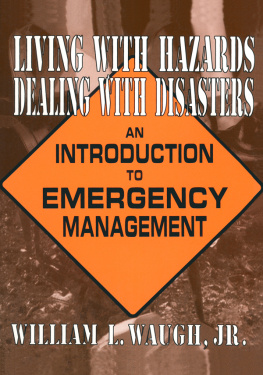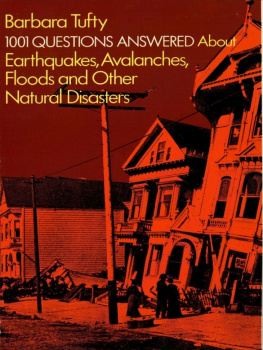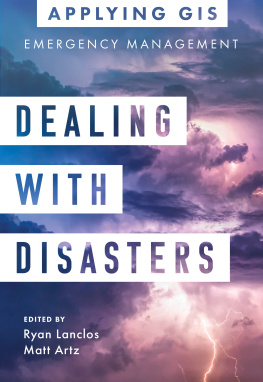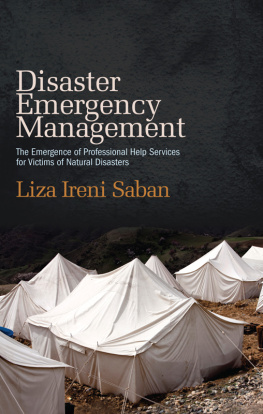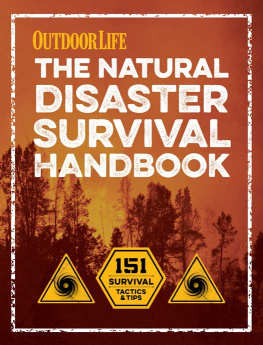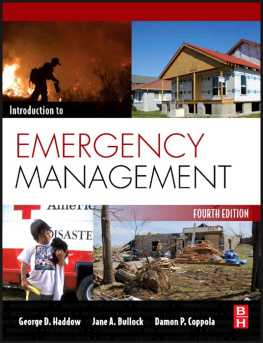LIVING WITH HAZARDS DEALING WITH DISASTERS
LIVING WITH HAZARDS DEALING WITH DISASTERS
AN INTRODUCTION TO
EMERGENCY MANAGEMENT
WILLIAM L. WAUGH, JR.

First published 2000 by M.E. Sharpe
Published 2015 by Routledge
2 Park Square, Milton Park, Abingdon, Oxon OX14 4RN
711 Third Avenue, New York, NY 10017, USA
Routledge is an imprint of the Taylor & Francis Group, an informa business
Copyright 2000 Taylor & Francis. All rights reserved.
No part of this book may be reprinted or reproduced or utilised in any form or by any electronic, mechanical, or other means, now known or hereafter invented, including photocopying and recording, or in any information storage or retrieval system, without permission in writing from the publishers.
Notices
No responsibility is assumed by the publisher for any injury and/or damage to persons or property as a matter of products liability, negligence or otherwise, or from any use of operation of any methods, products, instructions or ideas contained in the material herein.
Practitioners and researchers must always rely on their own experience and knowledge in evaluating and using any information, methods, compounds, or experiments described herein. In using such information or methods they should be mindful of their own safety and the safety of others, including parties for whom they have a professional responsibility.
Product or corporate names may be trademarks or registered trademarks, and are used only for identification and explanation without intent to infringe.
Library of Congress Catloging-in-Publication Data
Waugh, William L.
Living with hazards, dealing with disasters : an introduction to
emergency management / by William L. Waugh, Jr.
p. cm.
Includes bibliographical references and index.
ISBN-10 0-7656-0195-8 (cloth : alk. paper)
ISBN-13 978-0-7656-0196-4 (pbk : alk. paper)
ISBN-10 0-7656-0196-6 (pbk : alk. paper)
1. Emergency managementUnited States. 2. Disaster relief
-United States. I. Title.
HV551.3.W38 1999
363.348dc21 9941194
CIP
ISBN 13: 9780765601964 (pbk)
ISBN 13: 9780765601957 (hbk)
CONTENTS
TABLES
FIGURES
APPENDIXES
CASES
E mergency management is one of those fields that grows the more one gets to know it. Drawing the boundaries of the field is getting to be very difficult. The temptation is to include everything from radon gas contamination to alien invasion. Emergency management is also one of those fields that provides a fascinating array of issues. How people deal with risk says a lot about human nature. How communities deal with risk says a lot about social values and structures. How government deals with risk says a lot about our institutions and political culture. In many respects, emergency management provides testament to the utility of the current public policy models. Crisis disrupts the complacency that normally pervades the public agenda.
Hazards and disasters are the reasons we have government. The multitude of natural and technological hazards that exist in modern society provide more than enough risk to justify government intervention and to enlist the aid of public, private, and nonprofit organizations and of individuals. Disasters also bring out the best and the worst in human beings. Greed and selfishness are balanced by compassion and altruism.
Some choices were made in putting this book together. There is a growing social science literature on hazards and disasters and a wealth of information on specific disasters and how to deal with them. This book is intended to tie that literature together and to provide a sense of the culture of the field. Put another way, it is intended to link social science research with the war stories that permeate the practice of emergency management. There have been catastrophic disasters that have shaped our emergency management policies and programs and many have been included in short case studies. There are also processes that follow each major disaster in the United States and most are described or illustrated through the Federal Emergency Management Agency (FEMA) and the Office of Foreign Disaster Assistance (OFDA) announcements and situation reports. There is an incredible amount of information available via the Internet, and Web sites are noted whenever practicable. Web addresses change so frequently, however, that it is better to provide home page addresses rather than very specific document or program addresses. For instance, students can easily track information through the FEMA web page and its library.
In works such as this, it is always difficult to thank all those who contributed. In the references, some names appear frequently and many of those people are my friends. Also, a number of the references cited are from former students who found emergency management interesting enough to warrant thorough research. I would like to say that the analysis is based on rigorous scientific research, but, while there is some of that, there is also information from conversations with emergency managers, disaster researchers, and others with more interest than expertise. I thank them for their insights and observations. I would also like to thank the retired general overheard in a bar discussing relations between two nonprofit organizations during a disaster relief operation, the local emergency manager who made a conference presentation on his difficulties in dealing with state officials, the official who made a public speech on weapons of mass destruction without betraying any real knowledge of what he was talking about, and many others who contributed without knowing it. I hope that their experiences have been accurately interpreted here.
Statistics on human and property losses vary from source to source, and I have had to guess which were the more credible numbers more than once. However, all errors of fact and omission are my own.
William L. Waugh, Jr.
LIVING WITH HAZARDS DEALING WITH DISASTERS
I n an era in which the role of government is being reduced and programs are being cut, the scope and practice of emergency management are expanding rapidly and the field is becoming professional in response to the demand for technically and politically skilled emergency managers. The principal reasons for the increased interest in and support for emergency management policies and programs are an increase in the number of major disasters in recent years, the increased exposure of people and property to natural and technological hazards, and, perhaps most important, the critical nature of the function. Emergency management is the quintessential governmental role. It is the role for which communities were formed and governments were constituted in the first placeto provide support and assistance when the resources of individuals and families are overwhelmed.
In the simplest terms, emergency management is the management of risk so that societies can live with environmental and technical hazards and deal with the disasters that they cause. Emergency management is not solely a governmental responsibility. Individuals are responsible for protecting their own lives and property, as well as the safety of family members and neighbors. When they do not have the wherewithal to protect themselves as individuals and families, they can rely on the resources and capabilities of the community. In some cases, the support of a few neighbors or a single community is sufficient. In other cases, the support of a broad network of public, nonprofit, and private organizations is necessary to respond to and recover from major disasters. When the economic and social costs of disaster become unacceptable, a broader approach to hazard management and risk reduction is needed. As other values, such as protecting the environment and the quality of life, become important issues, the approach needs to be even broader. When the interests and needs of the community become more important than those of the individual, trade-offs are necessary. All this is to say that the politics of emergency management can become intense as individuals and organizations weigh the costs of potential disasters against their own economic and social interests. Policy choices have shaped the current national emergency management system and have had profound impact on its effectiveness.
Next page
